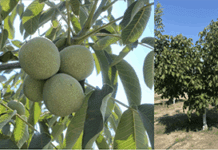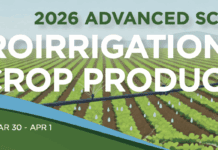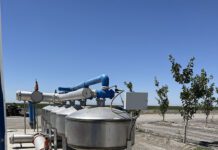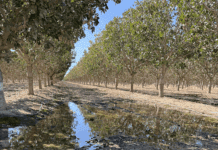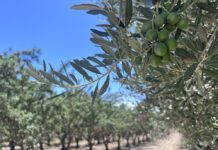Facts about the historical groundwater management mandate in the San Joaquin Valley were all part of Sustainable Groundwater Management Act (SGMA) Survival Toolkit meetings hosted by American Pistachio Growers (APG).
Richard Matoian, executive director of American Pistachio Growers said the goals with the workshops are to keep growers informed about SGMA, enactment dates, potential restrictions on pumping, and other important news so they can be better informed as its implementation moves forward.
SGMA Educational Workshops
SGMA will have an impact, and APG wants growers to understand how they will be affected .This is not the last of these types of workshops, Matoian said as this will be an ongoing educational process over the next several years, if not decades, as the various SGMA implementation dates take effect.
Even though groundwater management plans for targeted sub basins are required by January 2020, Don Wright, meeting moderator said groundwater sustainability agencies would be collecting data to fill in the unknowns about groundwater supplies.
“Don’t panic,” said Scott Hamilton of Hamilton Resource Economics. Hamilton, a panelist and former board president of Cawelo Irrigation District, said although groundwater sustainability plans were required to be complete by 2020, their acceptance by the state does not mean there will be immediate restrictions on groundwater pumping. How quickly pumping is restricted, Hamilton said, depends on the groundwater sustainability agency (GSA) and water district where an irrigation well is located.
“Nothing says you have to cut back now,” Hamilton said. “SGMA requires a plan for sustainable groundwater pumping.”
The plans submitted by GSAs require that six undesirable results are avoided by groundwater pumping. They include chronic lowering of groundwater levels, significant and unreasonable reduction in groundwater storage, significant and unreasonable seawater intrusion, significant and unreasonable degraded water quality, significant and unreasonable land subsidence and depletions of interconnected surface water that have significant and unreasonable adverse impacts on beneficial uses of surface water.
Occurrence of any of the six sustainability indicators constitutes an undesirable result.
Lack of Data
Michael Hagman, executive director of East Kaweah GSA, acknowledged that changes will come for agriculture due to the volume of groundwater overdraft. The role of SGMA, he said, will be to minimize the effects of reduced groundwater pumping and how to allocate the supply to landowners.
The ‘big unknown’ in the process is how much water is in the ground, Hagman said.
The lack of data will be a challenge for planning an allocation said Lauren Layne, a partner in the Fresno law firm Baker, Manock and Jensen.
Groundwater sustainability plans are required to estimate a sustainable yield, but data is needed to determine the numbers. Layne said the current data is historical and yield models based on those numbers are at this time ‘the best they can do.”
We know we are in a state of overdraft, Layne said, but don’t know the level. Groundwater Sustainability Plans are doing the monitoring to capture data and working toward more reliable numbers to base yields. Agencies have another 20 years to achieve a balance.
In the meantime, Layne said, GSAs are working on land-based assessments to operate. Monitoring equipment and wells are huge costs for agencies and since SGMA is an unfunded mandate, landowners must bear the costs.
These agencies may need to implement Proposition 218, to impose fees, Layne said. This Proposition, passed in 1996 requires an election by landowners. Lacking an adequate plan and assessment, the state has the right to come in and charge whatever fee they want and landowners have no say.
Funding
Funding for agency work is available from state Department of Water Resources where it applies to monitoring wells, drinking water supplies and water quality.
By 2040, Layne said there should be better information about groundwater supplies and costs and then talk of water trading can begin. There won’t be trading in the next five years, she said.
A second panel of speakers laid out ways to improve irrigation well and water delivery efficiency, and to manage energy costs.
Services include acid washing well casings to maintain groundwater levels, well rehabilitation improved irrigation system design. Older systems are less efficient said Kiel Taylor of Landmark Irrigation and the reduction in performance can result in higher operating costs.
Greg Allen, vice president of Red Trac, a Bakersfield company that specializes in pump efficiency, had a different take on SGMA- noting it also stands for “Survival Guide to Managing Assets.” Red Trac specializes in well efficiency, irrigation system water quality and management. Allen said that knowing operating efficiency of all systems and having the data on usage would assist with managing assets.
An innovative irrigation system that features unique ‘Aquifer pipe” was explained by Joseph Villegas of Drought Diet Products. The design of the pipe allows water delivery at the root zone, keeping the top six inches of the soil dry. The pipe shape prevents deep percolation of irrigation water, Villegas said.
Planning for the future of the San Joaquin Valley will require collaboration between state and federal leaders and stakeholders, said Fresno-based water attorney Austin Ewell. He urged participation in the San Joaquin Valley Water Blueprint which is designed to serve as Governor Gavin Newsom’s Californian Water Resiliency Plan. Role of the collaborative effort, Ewell said, is to plan for what the Valley will look like in the future.
Capturing more flood water and using recharge basins will be part of the answer to the Valley’s groundwater overdraft, said panelist Scott Hamilton. However with a projected 2.5 million acre foot total overdraft, another source of water will be critical. That water can be found the Delta, Hamilton said, but restricted pumping due to Endangered Species Act as well as biological opinions means the outflows during winter months flow into the ocean.
The Blueprint plan is looking at a different type of ‘fish-friendly’ diversion in the Delta. Tile drains are not new technology, Hamilton said, but installation in key areas of the Delta during could allow more water to be channeled back to the Valley for irrigation.
What is done with the water moving into the canals is still ‘very conceptual’ Hamilton said. Canals would be necessary to move the water to recharge pumps.
“There needs to be a lot more people involved in this. It can’t just be a few in D.C. but all communities need to be part of the solution.” Get engaged and get involved, Hamilton told growers. “There is a lot a stake-one million acres in the Valley.”

Cecilia Parsons
Cecilia Parsons has lived in the Central Valley community of Ducor since 1976, covering agriculture for numerous agricultural publications over the years. She has found and nurtured many wonderful and helpful contacts in the ag community, including the UCCE advisors, allowing for news coverage that focuses on the basics of food production.
She is always on the search for new ag topics that can help growers and processors in the San Joaquin Valley improve their bottom line.
In her free time, Cecilia rides her horse, Holly in ranch versatility shows and raises registered Shetland sheep which she exhibits at county and state fairs during the summer.




